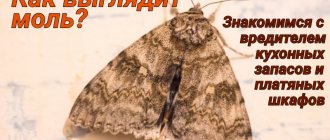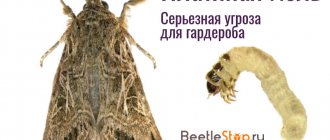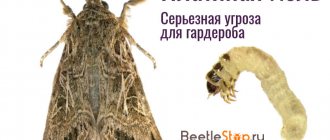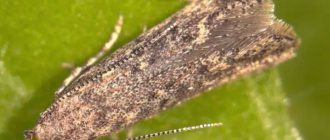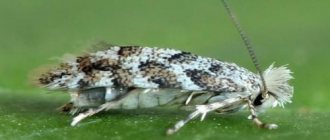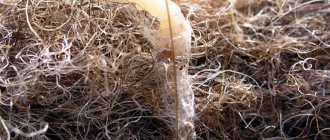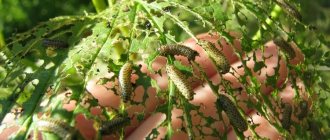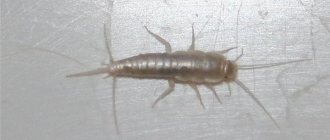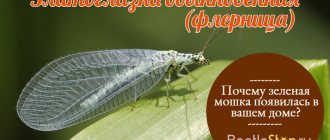- home
- Pest control
- Removing clothes moths in an apartment
- Types of moths
A moth is an insect that absorbs the substance of the stratum corneum - keratin. Such organisms are also called keratophages. But despite this, we often notice these insects crawling in the closet or flying around the house in search of woolen items. Why are they so attracted to wool? The answer is simple: at the molecular level, wool and fur contain the moth's favorite food product - keratin. Thanks to the unique environment of the stomach, which contains a lot of acid, moths easily digest keratin.
What you need to know about moths
The moth can be characterized by the following characteristics: it looks like a small butterfly of brownish-yellow, pale gray or white with a lot of silvery pollen on the wings. This insect goes through the following stages of development: the eggs hatch into larvae, then they become butterflies, and the adults, in turn, lay eggs. Moths themselves are practically harmless. You should be wary of larvae that hatch from eggs laid by butterflies in the fibers of things.
It is important to note that butterflies experience discomfort from sunlight, so they mainly live in dark places that are difficult for sunlight to penetrate - for example, in closets, closets and chests of drawers. The offspring hatched from the eggs, like butterflies, prefer to be in the dark, where it is almost impossible to detect the larvae. It should be noted that in the cozy conditions of city houses, moths are able to lay eggs all year round!
Reasons for appearance
The moth is different in that it can appear in a home where cleanliness and order are maintained. Some housewives believe that they are not to blame for the appearance of moths in the apartment. Actually this is not true. Despite cleanliness and order, these insects are attracted by completely different factors, such as the presence of freely available bulk food or the presence of knitted items made from wool and other natural ingredients. Often, housewives do not pay due attention to the process of storing these components.
Moths can enter a home:
- Through open doors and windows.
- From the entrance, if they live in other apartments.
- With used furniture.
- Through cracks, air vents.
- With used things.
- With food purchased in a supermarket or market.
Lifespan of a moth
This is a rather important question, considering that insects actively eat clothing and furniture.
Before the onset of puberty, the individual goes through two stages of development: egg and larva. At an air temperature of 20 degrees Celsius, the laid egg takes two weeks to develop. The larval development period varies from three to ten months. At this time, the larvae form a cocoon around themselves from the nutrient material, in which they develop further.
After acquiring wings, the individual does not live very long - only 2-4 weeks. This period varies depending on the type of parasite. During these weeks, individuals are not particularly mobile and fly mainly in the dark, since the wings are poorly developed, which makes the insects very vulnerable.
If you add up the three periods of time during which the life of a moth occurs, you get a very impressive period of time during which the parasites do not waste time destroying interior items and wardrobe items.
Chemicals
Fumigators are very popular in the fight against moths. These electrical devices operate from an electrical network and, when heated, begin to emit gaseous substances that are poisonous to insects.
Sprays and aerosols that are sprayed indoors are also very popular; they allow you to fight moths at all stages of development. Furniture, clothing, and wooden structures are processed. The active components act instantly. You can also purchase traps, they have a special adhesive tape.
These insects cannot tolerate the aroma of cedar. Tree bark and twigs can be placed in cabinets. Essential oil has no worse effect; pieces of cotton wool are soaked in it. Laundry soap is very popular and effective.
It is applied to cabinets and shelves. Naphthalene shows high efficiency, but due to the fact that it emits dangerous carcinogens, it cannot be used against food pests.
What types of moths are there?
The most common types found in the home are:
Fur moth
The fur moth is an individual that has shiny dark yellow wings, with dark specks on the wings. The lower layer of the wings differs in color from the outer ones: they are light gray. The wingspan ranges from fourteen to fifteen millimeters. The fur moth prefers to feed on clothing made from natural materials. The hatching larvae look like worms, have white, almost transparent skin, through which the contents of their stomach can be seen, and eight very short abdominal legs. The larvae prefer to consume fur products.
Clothes moth
The clothes moth is larger in size than the fur moth; its wingspan is up to twenty-two millimeters. She also has two pairs of wings, which are purple at the very base, turning yellow towards the middle, with a small brown spot at the very top. The clothes moth larva is covered with a small white fluff and is similar in appearance to the coat moth larva. But, unlike their relatives, clothes moth larvae prefer to huddle in folds or inside woolen material, eating fairly large spaces of material that are invisible from the outside at first glance. The larvae are kept on clothing by a stationary cover.
Furniture moth
Furniture moth - a representative of this species has shiny silver-yellow wings, the head is dark yellow, and the base of the wings has a brown tint. This variety of keratophages has a significant difference from all other species and thanks to this it was declared a separate genus. This difference is the absence of oral tentacles. Furniture moth larvae destroy furniture in a unique way: first, the hair padding in the soft parts is eaten, then, closer to the pupation period, the larvae appear on the surface of the upholstery and begin to gnaw tunnels in the furniture cover. Pupation occurs on the lower surface of chairs, armchairs, sofas, and beds. In such places, a huge number of light cocoons accumulate. The period of development of larvae depends on the time of year: in winter it is five months, in summer – about two months. Pupation, as a rule, occurs towards the end of winter, that is, in February.
Ermine
They are street species and differ in external characteristics. The size of the body is about 2 cm, the wingspan is 16-22 mm. The front wings have a snow-white color and a silvery tint; black spots can be seen on them.
On the head there are thread-like antennae that resemble a crest. Their diet consists of useful plants; they prefer bird cherry, apple trees, etc. Bird cherry is a favorite food, so they were given another name - bird cherry moth.
Agricultural pests
It is better to study the enemy thoroughly so as not to get confused if you suddenly have to meet him not only in the apartment, but also in the garden! It is quite common for entire colonies to attack agricultural crops, poisoning the lives of gardeners. Let's look at several main types of moths:
grain moth
The grain moth is a species of keratophagous silvery-white with a small bright brown pattern on the fore wings. They can also be recognized by their gray belly and wings, the span of which reaches up to fifteen millimeters. Pupation occurs primarily in spring and summer. Grain moths can most often be found in barns, warehouses, granaries and other places where grain crops are stored. An individual grain moth lays up to a hundred eggs directly on grains: one or two eggs are glued to each grain. The female combines several grains into a kind of lump with the help of a sticky liquid secreted, similar to a web, and eats them while inside this lump of web. To move, she has to drag the entire bundle behind her. This type of moth prefers to pupate in cracks in the floor and walls. In addition to grains, moths also eat dried fruits and various seeds.
Rye moth
Rye moth - this species has a wingspan of up to thirteen millimeters. The hind wings are dark yellow, with a brownish edging. The most common rye moth is found in central Russia. Individuals prefer to lay eggs towards the end of summer on wild cereals and on emerging winter crops. The larva eats the core of the stem and spends the whole winter in it. Pupation of rye moth larvae occurs closer to mid-summer.
Folk remedies
Before using harmful chemicals, you should try to remove insects from your home using safe methods - traditional ones. You need to study the methods in advance, choosing the one that suits you. It is worth remembering that folk remedies will not kill, but will only scare away the pest, so they must be used in combination with mechanical methods (for example, using a vacuum cleaner).
Various plants and herbs have a depressing effect on pestra. You can make a wreath or broom from the following plants:
- sagebrush;
- tansy;
- lavender;
- rosemary;
- mandarin.
Herbs can be put in fabric bags and scattered around the apartment. If there are too many moths, this method will not help.
Poplar moths do not like the smell of cedar essential oil, so it is used to make home remedies
The smells of essential oils - cedar, wormwood, eucalyptus, tea tree - have a deterrent effect. They can fill the phytobarrier and place it in the place of greatest concentration of moths. The capacity needs to be renewed every month. This will not only get rid of poplar moths, but will also give the room a pleasant aroma. You can place dry lavender branches, strawberry-scented soap, and orange peels in dark places.
Previously, housewives made pestra cubes, laying them out throughout the apartment.
To prepare them you will need:
- a few drops of lemon oil;
- detailed cedar bark - 115 g;
- myrrh - 115 g;
- cinnamon - 115 g;
- soap powder - 35 g;
- a few drops of alcohol;
- ground black pepper - 115 g.
The ingredients are mixed, alcohol is added until a sticky mass is formed. The resulting composition is used to make cubes that are laid out behind curtains, near windows, and household appliances.
An easier way to prepare cubes is to take 500 g of alabaster, add 50 g of ground black pepper, and pour in 40 g of naphthalene. Alcohol is added to the mixture until a ball is formed. They are scattered throughout the housing.
A sachet against moths gives an excellent effect. To make it, you will need to take 500 g of lavender, 1.9 kg of camphor, 30 ml of lavender ether. They are mixed, finely chopped and placed in boxes or bags.
You can make paper with an insect repellent scent.
To do this you need to mix:
We advise you to read:
How to deal with the smell of sweat
- 25 g camphor;
- 15 ml cedar oil;
- 25 g phenol;
- 350 ml gasoline or kerosene.
When preparing the mixture, you must follow safety precautions, as it is flammable. Some components are harmful to pets, so it is better to give your pets someone to look after during the procedure.
If pestra is noticed on indoor plants, they need to be treated. You can use a solution of laundry soap. Pieces of soap with the scent of citrus, mignonette, and lily of the valley can be placed in places where moths are spotted.
The insect does not like the smell of cedar, lavender and cloves, lemon, orange. If you buy flavors with these aromas, there will be significantly fewer individuals. You can soak tampons with essential oils of plants and place them in inconspicuous places in your apartment. Instead of orange essential oil, you can use fresh fruit peels. As they dry out, about once a month, they will need to be replaced with new ones.
Indoor plants will help drive away moths. Insects cannot stand proximity to geraniums, tobacco and nettles, so it is advisable to place them on windowsills. The smell of leaves will scare away unexpected guests - pests will not be able to enter the home through the windows.
Tobacco in a fabric bag is another effective means of repelling poplar moths. It needs to be laid out on the window sills and on the floor. Having sensed a pungent odor, insects will not stay in the apartment for long.
Dried chestnut fruits will also help you forget about the unpleasant problem. They are laid out in places where moths are spotted.
Important! When using folk remedies, you need to remember that they help scare off adult moths; you will need to get rid of the larvae using more radical methods.
Potato moth
This representative of parasites does not have the most attractive appearance: the wings are dirty gray in color and dotted with dark spots.
But in the larval stage, the individual is more pleasant to look at and has a light green (sometimes pinkish) color.
Having fledged, the individual acquires long mustaches and a body length of up to seven millimeters with folded wings. Life in this stage lasts only a few days.
The unprepossessing appearance appeared for a reason: it helps the pest remain unnoticed, even if you look at it, as they say, “point-blank.”
Females lay eggs on the surface of leaves on the underside. The larvae that hatch after some time develop very quickly.
As the name suggests, potato plants suffer from parasites. Individuals can remain alive until the temperature drops to 4 degrees. But individual individuals can climb into the tubers themselves and continue to exist there. Potato moths wait out serious cold weather, as a rule, in barns, which have enough seed potatoes for food. With the same potatoes, parasites re-enter the soil in the spring.
Apple
A small moth with a fairly bright color. They have snow-white wings with black spots. This pest brings great trouble to gardeners. They are active during periods of apple flowering and fruit ripening.
They infect foliage and spin webs. Eggs are laid in the bark; the female lays up to 65 eggs at a time. It is the larvae that pose the greatest danger; adult moths do not have a proboscis for feeding. Large populations can destroy entire gardens.
Cabbage moth
This parasite causes damage to cruciferous crops. Externally it differs from other types of moths: the body is oblong in shape and light green in color, covered with small hairs. You can easily confuse an insect with a straw if it folds its wings. The wings themselves are framed with fringe at the edges. The larvae have characteristic brown heads.
In terms of activity, cabbage pests are no different from the rest: they are inactive, fly poorly, and rarely move very far from the place where the cocoon is left. Parasites lead a solitary lifestyle and rarely gather in groups. On a leaf you can see one, maximum two individuals.
It is easy to detect and identify the eggs of the parasite: they are elongated and very small. The egg is up to 0.5 millimeters long and only 0.2 millimeters wide. The green color perfectly camouflages them on the foliage.
Clothes
As the name suggests, insects live on woven materials. They cause great damage by gnawing through large spaces in fabric products. The diet consists of wool, cotton, knitwear, and textile parts of upholstered furniture.
They have wings of a yellowish or purple hue, a wingspan of 22 mm. The larvae have cloudy white coatings. Females lay offspring in the cavities of the material.
food moth
It parasitizes inside products whose storage conditions have been violated. These are mainly stocks of cereals and groceries in barns. Parasites also find food for themselves in the wild: nuts and crop fruits become prey. For this reason, food pests can often be seen in steppe and forest-steppe areas.
It is curious that this type of moth is not able to cause harm to furniture and clothing, since it can only consume cereals, flour, sugar, dried fruits and berries. Appearance: body length with folded wings is eight millimeters. The discreet color makes the parasite almost invisible.
The caterpillars have a pinkish or light yellow color and a smooth body. Ideal conditions for development are: temperature up to +25 degrees, humidity up to 50%. All life stages of an individual take no more than six weeks.
Poodle
The appearance of these insects is surprising and even captivating. They are quite large, reminiscent of a snow-white fluffy poodle, which is made in miniature.
So, these mysterious insects were discovered in Venezuela only in 2009. It is very difficult to meet them in natural conditions. They have not yet been studied and remain a mystery to researchers and scientists.
Chestnut moth
The foliage of maple and horse chestnut suffers from it. After spending the entire winter in the pupal state, adult insects emerge with the first warmth. Reproduction processes soon begin, which end with the appearance of new offspring within a couple of weeks. The young growth immediately clings to fresh foliage. This causes early leaf fall and tree death.
The destructive activity of the parasites can be seen by uneven orange spots on the leaves.
Signs of plant damage
The fact that poplar moths have appeared on trees can be understood by the fact that traces of caterpillar life appear on their leaves. Their shape depends on the type of wood:
- On apple leaves, the passages can be round or serpentine.
- Brown or beige markings appear on pear leaves.
- Small holes appear on rose leaves.
- Light passages and dots are visible on damaged lettuce and violet leaves.
- You can see white dots on the leaves of the cucumber.
- When infected, light zigzag marks appear on the leaves of chrysanthemums.
Difficulties in killing moths
The shelves of hardware stores are filled with insect repellents. However, modern pests can extremely quickly adapt to what they are trying to poison them with. This complicates the disinfestation procedure. You have to change medications regularly. And despite all this, final victory rarely comes.
In view of this, it is easier to take care of preventing the appearance of pests. Preventive measures will vary depending on the type of moth. Recommendations on the algorithm of actions in your situation should be obtained from specialists.
Habitat
The poplar moth is a nocturnal insect. Individuals are most common in the European part of Russia and in the countries of Central Asia. The larvae prefer to feed on laurel, pyramidal, balsam and sweet perennial poplar. First of all, perennial trees are attacked. Vegetation pests avoid areas with wild forests, black poplar and Canadian poplar.
The habitat of the poplar moth often overlaps with the growth of cultivated plants. If fruit trees grow next to a poplar, they also suffer from caterpillar infestations. Insects cause great damage to plants in nurseries and greenhouses. Damage to the deciduous parts of trees leads to poor growth and low yields.
